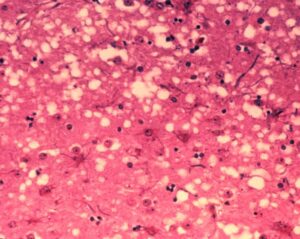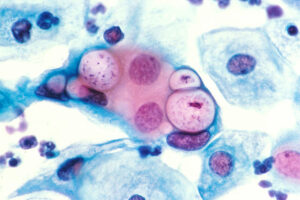In this post, you will find the obligate parasites examples their characteristics and detailed facts.
The Obligate parasites are those parasites that depends on their host to complete their life cycle. They are also called holoparasites.
The Obligate parasites examples are:
Rickettsia
They are very tiny, non-spore-forming gram-negative bacteria. They are pleomorphic, usually found as small Cocco-bacilli. They are spread by various arthropods like lice, ticks, and fleas. These are obligate intracellular parasites, and they live inside the bacterial cell or animal cells. They cannot survive outside the host body, just like virions.
Example: Rickettsia rickettsii causes Mountain spotted fever
Chlamydia
These are the tiny obligate intracellular parasite. Species of chlamydia cause various problems in humans, and arthropods do not transmit them.
Example: Chlamydia trachomatis causes severe eye illness and is also a causative agent of STD. Chlamydia pneumoniae causes lung contagion.
Mycoplasma
It is an extracellular obligate parasite that has developed the ability to attach to the host cells. Mycoplasma can damage host cells by producing hydrogen peroxide and superoxide radicals, which activate the immune response.
They can directly enter the tissues and replicate within the host’s cell. Species like Mycoplasma genitalium is one of the emerging cause of STDs.
Example: Myoplasma pneumoniae causes chronic lung ailment or asthma in patients.
Lice
They are obligate parasites that live externally on warm-blooded animals’ surface, in their hair or feathers.
Removing them from the host can make them die. They can survive their entire life on a single host by planting their eggs called nits in the feather or hairs of the host. Eggs hatch and transform into nymph where they molt three times to become fully mature.
Example: The human specie is Pediculus humanus.
Virion
All virions are an intracellular obligate parasites. They require host metabolic machinery to replicate their DNA or RNA to make viral proteins.
Virion contains the protein coat called a capsid, which helps the virion protect its genes outside the cell and serves as a carrier to switch into another host because it can bind to the receptors of the host cell. An example of obligate parasites is Retrovirion which opts for host machinery to make their virion particles.
Prions
They are protein particles without having any nucleic acid. They are also intracellular obligate parasites and cause various abnormalities in animals and humans. They are so small and can escape the host’s defense mechanism.
Actual mechanism for the activity of prions is still unknown, but some theories suggests, they select protein similar to themselves from the membrane of brain cells and line up around the brain cells to make conformational changes and convert the brain cells into prions.

It causes brain disorder in sheep, cow and humans. Scrapie in sheep, Kuru in Humans
Trypanosoma
It causes African sleeping sickness. It is polymorphic and digenetic in nature. It is elongated, flat and colorless with length of 15-30μm. It is transmitted by vector -Tsetse fly (Glossina palpalis).
Bite of Tsetse fly releases the parasite in human blood, it gets the nourishment from plasma, multiplies by binary fission and then passes into pancreas and liver and cause damage to the organs.
Examples of obligate parasites : Trypanosoma gambiense and Trypanosoma rhodesiense.
Leishmania
It is dimorphic and digenetic in nature. The parasite is oval, small, non-flagellate in humans having 2-4μm in length called leishmania (amastigote). It is intracellular parasite mostly prevalent in India (U.P, Bihar and Bengal), Nepal, china. This parasite has a blood sucking vector called Sandfly (Phlebotomus). After introducing into the human body it passes into macrophages and then attacks white blood cells causing the breakdown of immune system. The skin, legs and abdomen become dark, hence the name is given Kala azar.
Obligate parasites examples of Leishmania are :
- Leishmania donovani causes Kala azar (Black fever).
- Leishmania tropica causes oriental sore or Delhi sore.
- Leishmania brasiliensis causes expundia.
Plasmodium
It is malarial parasite. It is digenetic, female anopheles mosquito is primary host while humans are secondary host. Sporozoite of plasmodium is mainly responsible for causing malaria. Once sporozoites are released by female anopheles saliva into human blood, sporozoites molts 2-3 times to develop the stage called merozoites that contains brown pigment granules called haemozoin which brings out the symptoms of malaria.
There are about sixty species found, out of which only four species occur in humans: Plasmodium malariae, P.vivax, P.ovale, P.falciparum.
Pneumocystis
It is a yeast-like fungus who shares biological characteristic with protozoa. Pneumocystis jirovecii is responsible for causing PJP (Pneumocystis jirovecii pneumonia) in immuno-compromised persons.
This pneumonia is parasitic type of pneumonia which occurs when CD4 count is less than 200 cells/ml. The symptoms are cough with scanty sputum, fever and breathlessness. This fungus is ubiquitous and air-borne, once entered into lungs, macrophages are activated to remove pneumocystis, we can find them in alveolar air spaces, as the pathogenicity increases, macrophages, T and B cell dysfunctions.
Characteristics of Obligate parasites.
- They exploit their one of the hosts if the life cycle is direct or indirect. The direct life cycle involves the exploitation of a single host, e.g Ancylostoma species, while the indirect life cycle exploits more than one host, e.g. malaria plasmodium.
- If the life cycle is indirect or complex, then the intermediate host is affected for short duration. The primary or final host are more likely to exploit.
- They are temporary or permanent. The permanent obligate parasites are can live upto as long as they can by producing number of generations while temporary parasites like mites are limited to single stage development and adult stage is non-parasitic.
- They live on their host as ectoparasites (Lice) and endoparasites (Chlamydia).
- Obligate parasites have evolved the host mechanism to suppress the apoptosis to make their survival.
- Obligate parasites can only survive in the presence of their host.
Frequently Asked Questions
Q1.What is black water fever?
–It is a malarial fever caused by the Plasmodium falciparum
Q2. What is the infective stage of the parasite Entamoeba histolytica?
–Tetranucleate cyst.
Also Read:
- Tapeworms characteristics
- Reverse transcriptase its basic mechanism
- How is enzyme denatured
- Types of chromosome
- Contractile vacuole in euglena
- Atp synthesis stages
- Do eukaryotic cells have cytoplasm
- Are bacteria aerobic or anaerobic
- Fungi cell membrane and bacteria cell membrane
- Gram positive bacteria examples

Hi, I am Saif Ali. I obtained my Master’s degree in Microbiology and have one year of research experience in water microbiology from National Institute of Hydrology, Roorkee. Antibiotic resistant microorganisms and soil bacteria, particularly PGPR, are my areas of interest and expertise. Currently, I’m focused on developing antibiotic alternatives. I’m always trying to discover new things from my surroundings. My goal is to provide readers with easy-to-understand microbiology articles.
If you have a bug, treat it with caution and avoid using antibiotics to combat SUPERBUGS.
Let’s connect via LinkedIn:
